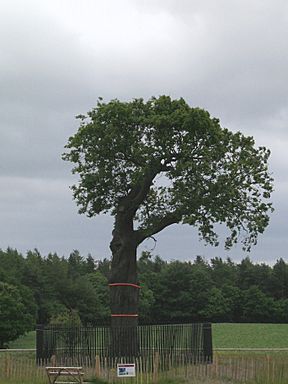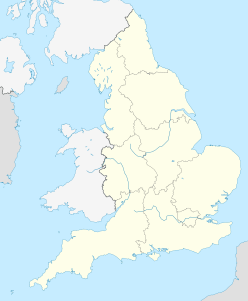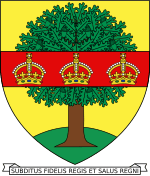Royal Oak facts for kids
The Royal Oak is a famous English oak tree. It is known because King Charles II of England once hid inside it. This happened in 1651, after a big battle called the Battle of Worcester. Charles was trying to escape from his enemies, the Roundheads.
The tree was located in a place called Boscobel Wood. This wood was part of the land around Boscobel House. Charles II later told a friend that a soldier from the other side walked right under the tree while he was hiding! This story became very popular. People still remember it every year on a special day called Oak Apple Day.
People even made special plates called 'chargers' that showed the Boscobel Oak. These plates often showed the tree being held up by a lion and a unicorn. You could also see the king's face peeking out from the branches.
Contents
The Story of the Royal Oak
Charles II's Great Escape
After his army lost the Battle of Worcester, King Charles II had to run away. He was with some loyal friends like Lord Derby and Lord Wilmot. They looked for safe places to hide, like White Ladies Priory and Boscobel House.
First, Charles went to White Ladies Priory. A man named Charles Giffard helped him get there. The Penderel family, who lived and worked there, became very important. They helped guide and care for the king. They even disguised Charles as a woodman.
From White Ladies, a man named Richard Penderel tried to help Charles cross the River Severn. But they couldn't, so they had to go back. Charles then found safety at Boscobel. On September 6, 1651, he met William Careless there. Careless was one of the last loyal soldiers to escape the battle.
Hiding in the Tree
Careless thought Boscobel House might not be safe enough. He suggested that the king hide in a large oak tree in the woods. So, Charles and Careless took some food and drinks. They spent the whole day hiding in this tree. It later became known as the Royal Oak.
From the tree, they could see enemy soldiers searching for the king. Later, Charles spent the night hiding in a secret room called a priest hole inside Boscobel House. After that, he moved to another safe house and eventually escaped the area. He pretended to be a servant of a woman named Jane Lane.
Rewards for Loyalty
After Charles II became king again in 1660, he remembered everyone who helped him. He gave money every year to the Penderel family. Their descendants still receive this money today!
For his help, William Careless was given a special job in the king's court. Charles also gave Careless a new last name, Carlos, which means Charles in Spanish. He also gave him a new coat of arms. Both the Penderel family and Colonel Careless received coats of arms that showed an oak tree and three royal crowns.
The Royal Oak Today
The place where the famous tree stood is near Boscobel House. However, the land where the tree is located is not owned by English Heritage, who look after the house. It is owned by a farming family, Francis Yates Partners. They let people visit the tree by following a path from the house's garden.
Son of Royal Oak
The tree you see there today is not the original Royal Oak. The first tree was destroyed over time by visitors. People kept cutting off branches and pieces as souvenirs! The tree standing now is believed to be a descendant of the original. It is about two or three hundred years old and is called 'Son of Royal Oak'.
In 2000, a big storm damaged the Son of Royal Oak. It lost many branches. In 2010, it was found to have large, dangerous cracks. Since 2011, a fence has been put around the tree to keep visitors safe.
New Generations of Oaks
Three more oak trees, which are descendants of the Royal Oak, have been planted nearby:
- In 1897, a tree was planted in the garden of Boscobel House. This was to celebrate Queen Victoria's 60th year as queen.
- Another tree was planted in 1951 near the original site. This marked 300 years since Charles II's escape.
- In 2001, Prince Charles (who is now King Charles III) planted an oak sapling. This sapling grew from one of the Son of Royal Oak's acorns.
You can even buy young oak trees that are grown from the Son of Royal Oak's acorns. They are sold at the English Heritage shop at Boscobel House.
Remembering the Royal Oak
Because of its importance in British history, many places and things are named after the Royal Oak. For example, 'The Royal Oak' is one of the most common pub names in Britain. Also, eight warships of the Royal Navy have been named HMS Royal Oak.




